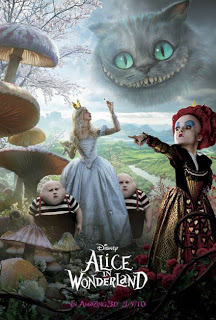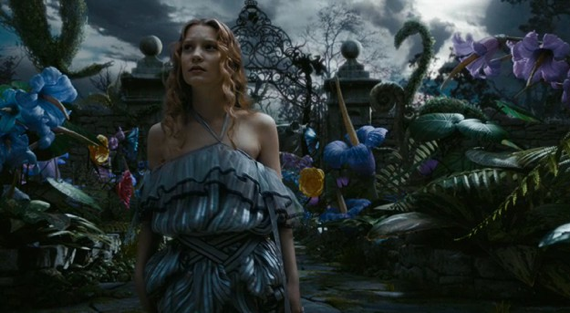 Re-recording mixer Tom Johnson answered some questions about his work on “Alice in Wonderland”. Tom mixed the film with frequent re-recording collaborator Michael Semanick on Sony’s Kim Novak dub stage. Johnson will be jumping on Universal’s animated feature “Despicable Me” next.
Re-recording mixer Tom Johnson answered some questions about his work on “Alice in Wonderland”. Tom mixed the film with frequent re-recording collaborator Michael Semanick on Sony’s Kim Novak dub stage. Johnson will be jumping on Universal’s animated feature “Despicable Me” next.
DS: This is your third film working with director Tim Burton, how does he embrace the dubbing process?
TJ: Tim is very much into the sound mixing process. He is incredibly attentive and precise in his desires. He is very much into the rhythm or tempo of the soundtrack. This is true of all of the elements (Music, effects and dialogue). For Tim, all of the elements have to work in terms of timing or beat. Just like the picture itself has a certain rhythmic pace, so to does the soundtrack as a whole. Often notes are given based on this feeling more than anything else.
DS: Has it changed since your first collaboration of “Charlie and the Chocolate Factory”?
TJ: Tim is just as concerned about sound as he has always been, meaning he is very focused. Sound is as important to him as anything else in the film. I would say that for Tim, all aspects of the film are equal in importance because he sees them as fitting together to make the whole piece. In terms of sound, all elements are also equally important to him. In the case of “Alice”, Tim wanted a very rich and detailed track full of texture and rhythmic precision.
DS: How did the sound team on “Alice” establish the sonic differences between London and Wonderland?
TJ: The above ground scenes (or the “London” scenes) are meant to sound “normal,” meaning rather bland and uninteresting. This is supported by the picture too, in that it is rather colorless and two dimensional. When we get to “Underland,” or “Wonderland,” the world sounds and looks colorful, exotic, and very deep or three dimensional. Strange birds, insects, frogs, and other animals were used to sonically convey this idea of Wonderland.
Also, we wanted each of the places to have their own particular sound. For instance, the White Queen’s Castle, which is near huge waterfalls and lots of vegetation, needed to have a fuller, lusher sound than the Red Queen’s Castle which is in a desolate environment. Also, the area where the final conflict takes place is very empty, with only a stark, lonely wind playing.
The idea was to make Underland sound very site specific and interesting; while the real world of “London” was to sound boringly normal.
DS: What sounds were you able to embellish while the film was “down the rabbit hole”, which wouldn’t work in England’s realistic setting?
TJ: In terms of Backgrounds, we were able to use things like exotic birds that would never be found in England. Plus we were able to use crickets and frogs that would never be found in the cooler climates of Great Britain, either. And, of course, there were all the creature specific voices of the Bandersnatch, Jub-Jub Bird, Jabberwocky, etc.
We were also able to layer sounds on top of each other in such a way that Underland becomes deeper, more three dimensional sounding than the two dimensional world of England.
While surround channel usage is usually dictated practically, by someone of something’s movement passing by the POV of the camera, what creative reasons did you guys utilize the rear speakers in the film? How do you know when to avoid using them? (i.e., panning takes away from the action).
We used the surround channels a lot to enhance the three dimensional world of Underland. We tried to give a sense of things coming off the screen by often putting them slightly (or often even more than slightly) into the surround speakers. We did this with the music and effects a lot, but also with the dialogue as well. For instance, at one point Alice tells the Caterpillar that she wouldn’t fight the Jabberwocky even if her life depended on it. He responds, “It will!” We put that line in the Center speaker AND the center surround speaker to give it a bit of emphasis as his head comes out into the theater. This kind of treatment does not work at all in the 2D version of the film; it was really distracting and we found ourselves looking around the room because we were really aware of the surround speakers (especially when it was dialogue we were putting there). But when we ran the 3D version of the film, this technique really seemed to work pretty well.
We also did a lot more panning of the dialogue in the 3D version of the film. In fact, when we were in Underland we were pretty consistent at trying to pan the dialogue to wherever the person was speaking was in the frame. There is much less panning of the dialogue in the 2D version.
DS: I always get a kick out of the smallest sonic details in a film, like in “Alice,” I loved the sound of the door mouse pacing while she’s locked up in the metal birdcage. What character had your favorite sounds to mix in the film?
TJ: In terms of the dialogue mix, I have to say that I enjoy the White Rabbit a lot. Once you realize that all of the “animated creatures” in the film were wholly created after their voices were recorded, it is truly amazing how fantastic their performances really are. For me, I never tire of watching the White Rabbit. His facial and body movements are a perfect match for his vocal performance. And once you realize that it was a wonderfully talented group of animators that made that character come alive frame by incredibly detailed frame, the whole performance is quite an amazing feat of creativity and collaboration between animators and actor.
And this is true of all the animated creatures in the film. It was quite exciting watching them come to life over the course of the film making process.
DS: Alice frequently and dramatically changes height in the film; how did you guys play with her aural perspective while she was small versus when she was normal sized or tall?
TJ: We discussed this pretty early on. The first thing we decided was to NOT change Alice’s voice quality when she was small or big. We felt that this would be really distracting, and would also take away from the basic performance and interaction between the different characters. We did do some subtle thi
ngs with reverb when she was in the round room towards the beginning of the film. When she is big the reverb is fairly tight and small because the room is now smaller compared to her body size. And when she was small we used a larger reverberant space because the room is now bigger and more alive compared to her body size.
We also used a deeper sound for some of her feet when she was larger. But in the rest of the film we really let the visuals tell most of the story.
I suppose if one was to theorize about this, the idea is that in the case of Alice’s size changes we felt that the visual elements were so strong that if we tried to be equally bold with the sound, it would most likely diminish the impact that the picture was having on us.
We did find that we could do things with backgrounds that would help. For instance, when she was small the sound of the grass would become important because the blades of grass were as big as she was.
DS: What was your first gig like?
TJ: I would say that many of my first jobs were pretty intimidating. I remember a film called The Hot Spot, directed by Dennis Hopper. It was one of the first times Gary Rydstrom and I were really on our own. I mixed dialogue and music, and it was really very scary for me. Here you have Dennis Hopper directing; a great score by Jack Nitzsche, performed by the likes of John Lee Hooker, Taj Mahal and Miles Davis; and me a virtual newbie! The first day of the final we do a run through of our predubs for Dennis. During the whole rundown I am sweating bullets. I mean this is Dennis Hopper, man! At the end of the first reel he tells Gary how much he loves the sound effects work he has done (and it was and is a really nice job; definitely a film worth checking out). Then he turns to me and says, “The dialogue sounds kinda weird. Why is that?” This has got to be the worse comment anyone can ever make about a dialogue premix. And it is truly my worst fear to this day. He then says, “Can we play the first scene again?” And so we do. There is silence at the end of it. It seems like days before Dennis says anything. Then he says, “I guess it is just that it sounds so much cleaner than I’m used to, is that it?”
I think the whole room sighed with relief (or probably it was just me, but it certainly felt like the whole room, or world, suddenly was feeling better). And from that moment on we had a really fun time…..

Since you mentioned the upcoming movie Despicable Me, we’ve got a site for costumes for both kids and adults this Halloween. Give us a look if interested.
Hello!:) <3 love you guys